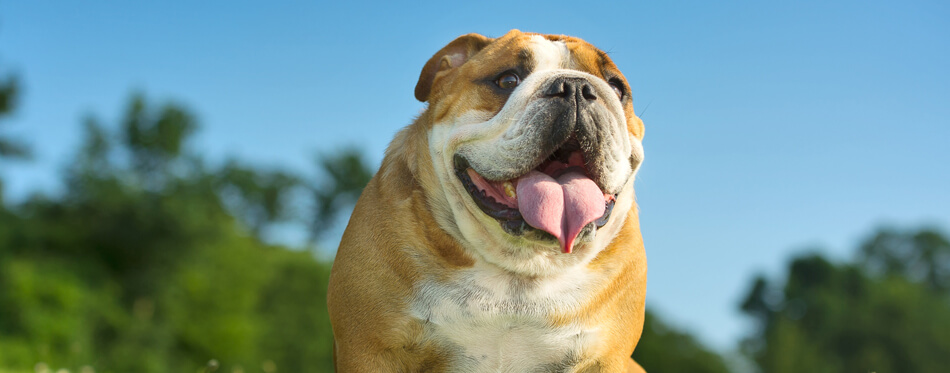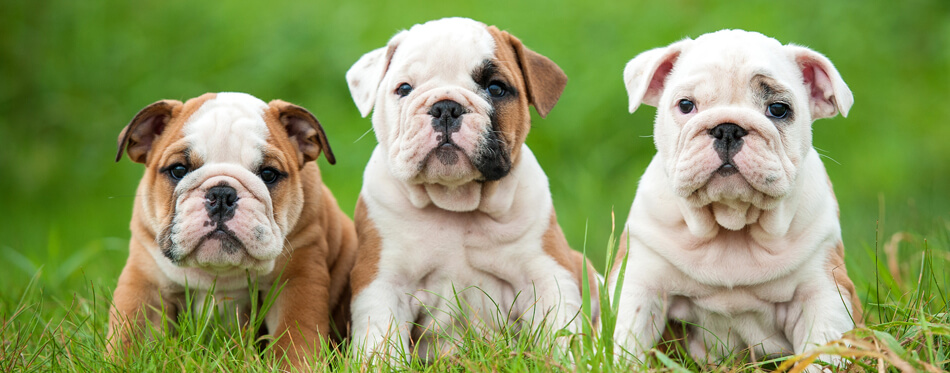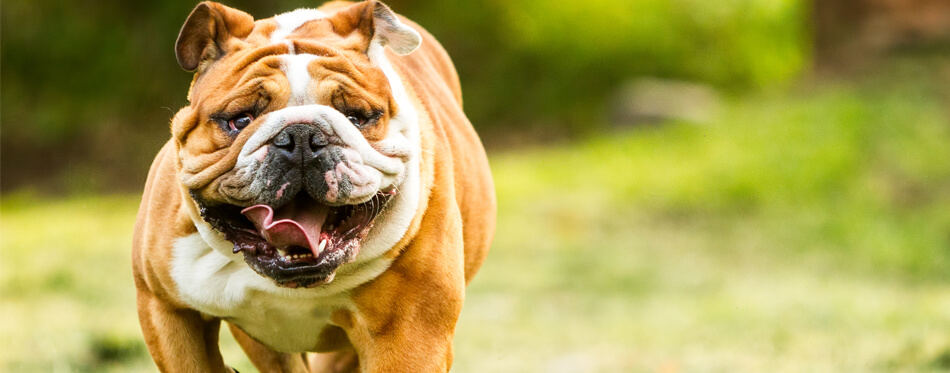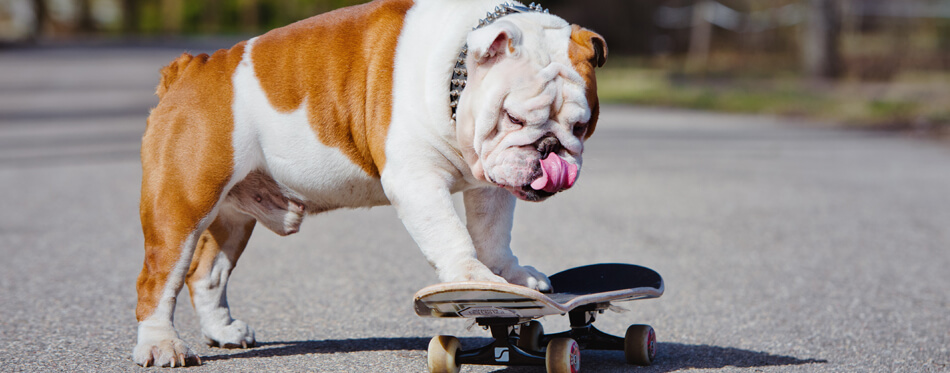The English Bulldog, otherwise known simply as a Bulldog or British Bulldog, is a loveable, flat-nosed, jowl-faced, stocky breed with a mild temperament and playful nature (despite their naturally grumpy-looking face). They are much loved as family pets, owing to their loyalty and low energy levels making them low-maintenance for a busy household. Additionally, their dignified stance and docile nature have made them quite popular with middle-class households. So if you’re thinking of nabbing yourself one of these loveable little brutes, we hope that this guide will provide any wannabe pet parents with all of the information you might need to make an informed decision.
Breed Overview
- Dog Breed Group: Companion Dogs
- Height: 12 to 15 inches tall at the shoulder
- Weight: 40 to 50 pounds
- Life Expectancy: 8 to 12 years
- Energy Level: Low

History of the English Bulldog
It is believed that English Bulldogs were originally bred to be used in the vicious “sport” known as bull baiting in 13th century England. The bulldog breed was chosen for this activity in which bulldogs would be pitted against a staked bull, with spectators watching for the outcome of the fight. They were chosen and bred for their incredible strength, their powerful, wide jaws, ferocity, and endurance. With the Bulldog breed originally being brutish and vicious. A far cry from modern-day bulldogs.
Bloodsports (which included bull baiting) were banned in England in 1835, which meant a change in the tide for Bulldogs everywhere. Bulldogs were bred with various terrier breeds to create more agile, fiery dog breeds with the strength and brutality of Bulldogs, that would fit the new underground pit-dog fighting rings. This placed original bulldogs on the brink of extinction, now considered obsolete.
In response to this risk, bulldog admirers banded together to work to soften the ferocious nature of the breed. With careful selective breeding refining and defining the shapes and contours, removing harsh lines and making them more attractive. During this time Bulldogs also went international, with admirers continuing the hard work in the United States. Eventually, they succeeded in developing a gentle, mellow, sweet dog breed, ideally suited to family environments. Their hard work eventually culminated in the breed being recognized by the AKC in 1886.
British Bulldogs became a national symbol of England during the Second World War. With certain comparisons being made between the English Prime Minister Winston Churchill and his jowly companion dog. The breed’s regal and dignified stance combined with its stocky, broad, muscular body presented the image of a strong and bold mascot. Something the soldiers and citizens during World War II needed. U.S. Marines also took a shining to the loveable pups, but without the mascot status.
Quick Breed Facts
- Most female bulldogs have to give birth via a cesarean section due to the broadness of their puppies heads being too broad for the birth canal, making natural labor difficult.
- British Bulldogs are particularly sensitive to cold weather conditions.
- Bulldogs also have a wear disposition for hot weather and humidity, with a tendency to overheat is not carefully monitored.
- Bulldogs are sensitive to anesthesia, meaning any surgery should be carefully considered and discussed with your vet.
- Bulldogs have a habit of overeating if they’re given the opportunity to, so they require careful portion control to avoid any unnecessary weight gain and keep their eating habits in check.
What Does an English Bulldog Look Like
Male and female bulldogs have few differences between them when it comes to physical measurements. The easiest difference to spot is the difference in their head sizes, as a female typically has a slightly smaller head than the male. Additionally, females tend to be slightly more slender, weighing around 10 pounds less than their male counterparts. English Bulldogs also have naturally very short stubby tails, sometimes straight and sometimes screwed. They shouldn’t ever have their tails docked unless it is for medical reasons. Docking an English Bulldog’s tail is not considered correct by American Kennel Club standards.
An English Bull dog will always have a strong underbite, resulting in their lower teeth jutting out on from of their mouth, and their bottom law curving slightly upwards. This flat face is easily the most recognizable and expected of the physical bulldog characteristics, alongside their short stocky stature. As a result of this severe underbite, the nose is always flattened with wrinkles of skin gathering around the nose and eyes.
Size
- Height (to top of head): 15 to 19 inches
- Withers Height: 12 – 16 inches
- Length: 20 to 27 inches
- Weight: 50 to 55 pounds (male)/40 to 44 pounds (female)
Coat
As you will see here, a bulldog’s coat can come in a wide variety of colors, with several marking possibilities that can mix and match with the expected colors. However, their coat length and thickness will always stay the same.
- Color: Fawn, Fawn & White, Fawn & Brindle, Fawn Brindle & White, Red, Red & White, Red Brindle, Red Brindle & White, White, Fallow
- Length: Short
- Texture: Smooth
- Markings: Black Mask, Ticked, White Markings, Piebald, Brindle, Black Tips
- Thickness: Double layered

Fun English Bulldog Facts
- Yale University has a British Bulldog mascot named Handsome Dan.
- The Bulldog is also the mascot of Mack Truck company and the U.S. Marine Corps.
- They may be small in stature but they can grow to be as heavy as 60 pounds.
- The “bull” part of “bulldog” is due to their historic connection with bull baiting.
- A Bulldog named Otto broke the Guinness World Record for the longest human tunnel ever skateboarded through by a dog.
Temperament
English bulldogs are extremely easy to get along with, despite their ancestry being made up of vicious fighter dogs. The successful selective breeding process resulted in gentle, quiet, loyal, proud, friendly, playful dogs that get on great with children and love plenty of human attention. As puppies, they have a tendency to display some stubbornness. Something that will require constant training in order to avoid potential behavioral problems in the future. Much like any intelligent dog breed.
Once past their difficult puppy phase, an adult British Bulldog can make an excellent family pet. Their gentle, yet playful nature makes them great playmates for children. Additionally, the English bulldog is a docile enough breed that they do have very complex or demanding exercise requirements. They are also not what you would consider a “working dog” unless you consider companionship work. Though please bear in mind that all dogs are unique and that their personalities are also a reflection of their living conditions, upbringing, and training.
Around Children
The English Bulldog gets on extremely well with children and makes an excellent family dog. They’re gentle and playful, dogs that are eager to please. Additionally, they don’t tend to bark very much, therefore you don’t need to worry about a noisy dog around young children or babies. Because their energy levels aren’t especially high a bulldog may not always show interest in engaging with children, however, this also means that they will get a lot of their mental and physical stimulation from playtime. Though if you intend you have your Bulldog around children, ensure that your children are aware of how best to handle them, as children are often unintentionally heavy-handed which can cause your dog to become stressed.
Around Other Animals
British Bulldog pets often get on quite well with other animals. Again owing to the fact that they are not particularly high-maintenance, energetic, or difficult to work with. In fact, they have even been known to get on fairly well with cat siblings. Though, as many pet owners know, it is better to have the bulldog first so that your cat can grow up around it. When it comes to other dogs, their non-threatening, docile temperament tends to work in their favor. Often meaning other dogs are not overly fussed by them.
English Bulldog puppies tend to adjust quite well to new homes, but they benefit from having companions to keep them company when their human family is busy. This is because the bulldog is a very affectionate, social breed, and so a bulldog will grow very attached to its family – animal or otherwise.
Care
As we’ve mentioned, the English Bulldog makes an extremely affectionate pet that enjoys the company of its owners. So pet care for these gentle dogs is relatively simple. They are not demanding, and actually, take pleasure in simply being with their family and receiving lots of fuss. It is worth noting that due to their social nature, they do well when having people around at all times. Therefore, on the flip side, they can struggle with separation anxiety when left alone for long periods of time. Alternatively, you could have a second dog for them to keep each other company. Bulldogs are a companion breed that seeks company, attention, and comfort.
Training
Socialising is important during early age with a bulldog in order to amplify and encourage that gentle response to people. Puppy training classes would also be highly beneficial for simple obedience. This is due to the fact that young bulldogs have a terrible habit of being quite stubborn during their adolescence. They are particularly troublesome when they are going through the teething phase, as bulldogs have very powerful jaws and are capable of causing a lot of damage very quickly (so keep anything valuable out of reach during these months).
The quicker you can train simple commands into your pup, the easier their adolescence will be to handle. Once your pup becomes an adult most of that attitude will subside, leaving the goofy, friendly, playful dogs we know and adore.
Potty Training
The stubbornness of puppydom may prove troublesome when it comes to potty training your bulldog pup. So be prepared for quite a few accidents, and potentially belligerent “accidents” if they are feeling particularly argumentative. However, they are not impossible to train by any means, it simply required perseverance, patience, and positive reinforcement. And perhaps keep them in the kitchen or in their crate with a puppy pad at nighttime.
Work
English Bulldogs are not manual labor dogs, nor are they sporting dogs. They are known as companion dogs, meaning they do best when accompanying a human. They take comfort and solice in being around their owner as much as their owner does in having them around. This is where their affectionate and kind nature really comes into play. Adult Bulldogs are perfectly suitable for pretty much any household, once they are past their difficult argumentative phase and have mellowed out.
Feeding
Owing to the fact that Bulldogs have a tendency to gain unnecessary weight quite easily, their food intake should be carefully monitored. Furthermore, because they can gain weight so easily, it is best to stick with a dry dog food diet, which often helps to slow a dog down as it eats since it will have to stop and chew. Slowing your bulldog’s feeding down assists easier digestion as well as encouraging them to savor their meals. Though make sure you stick to the correct portion size with your pup, no matter how often they give you puppy eyes. English Bulldogs will gorge themselves if given the opportunity, and so if you make the mistake of leaving food where they can get it, it probably won’t be there when you get back.

Health
The health of an English Bulldog dog breed, like all pure breeds, has its complications. This is particularly true of the English Bulldog because of the flat muzzle that has been bred into them over the years. The flat nose, wrinkles, and underbite have been a constant cause of complication for generations on bulldogs. The main health problems the Bulldog dog breed faces are:
Brachycephalic Syndrome: This syndrome causes breathing difficulties as a result of narrowed nostrils, or a short head obstructing their airways. The effects can vary quite significantly – anywhere from snorting and noisy breaking to the airways collapsing. A common sign of this syndrome is snorting and snuffling. If you are ever worried that your bulldog may be having breathing problems, do not hesitate to approach your veterinarian who will be able to assess the severity and plan treatment.
Head Shakes: Head shakes are somewhat unexplained at this moment in time. With theories ranging from low blood sugar to misfiring nerves in the brain. Most dogs that experience head shakes are aware that it is happening but incapable of stopping it. It has been likened to that of a seizure, with their head rapidly moving from side to side or up and down repeatedly. It doesn’t seem to affect any other area of their body, however, unlike a full seizure. Many bulldog breeders recommend honey to pick up their blood sugar levels and distract them until the shaking stops. If your bulldog appears to be uncomfortable or in pain, report the problem to your veterinarian.
Patellar luxation: This is one of the more painful health conditions that tend to affect smaller breeds. The bulldog may be short, but it is still extremely stocky and therefore suspectable to health concerns surrounding skeletal and joint problems. Patellar luxation is caused by a misalignment of the patella. It is a condition that is present at birth, however, the misalignment might not happen until significantly later and may lead to degenerative joint disease. Depending on the severity (which has a 4-grade system), treatment could range from simple physiotherapy to surgical intervention.
Other less severe health issues include:
Demodectic mange: Demodectic mange is caused by a mite that most dogs are born with. Though for many it may never make an appearance. But if your dog had a particularly weakened immune system they may become irritated with dry, itchy, scaly patches of skin that cause hair loss and become extremely uncomfortable for your pup when left untreated. It often only affects puppies but has been known to develop into generalized demodectic mange which can affect adolescent and adult dogs. Fortunately, it can be easily treated with medicated shampoo and antibiotics.
Entropion: Entropion of one of the multiple health conditions that can be caused by the significant wrinkles around their nose and face. Entropion is the turning inwards of your dog’s eyelashes due to the weight of excess skin around their eyes lushing the eyelashes inwards. This can cause significant discomfort and irritation for your pet. When only mild it can be treated with eye drops to reduce irritation and swelling. In more extreme cases surgery may be necessary to remove some of the excess skin.
Skin Irritation and Infection: This is more of a general concern that needs to be monitored. Tightly turned curled tails and excessive skin folds around the body and face can cause a build-up of bacteria that has the potential to become infected. Once infected the irritated areas can be difficult to clear up. So regular cleaning and thorough drying of the problem areas can help to avoid infection in the future.
Tooth decay: Because of the significant underbite, most bulldogs can struggle with their teeth. This is due to their teeth being exposed to the elements as opposed to protected by saliva. Therefore you need to ensure that their teeth are being brushed regularly and checked by your vet.
Exercise
As previously mentioned, British bulldogs do not tend to have an excessive amount of energy and are not overly demanding when it comes to their exercise routine. Like all canine pets, they require exercise – especially given that they often struggle with their weight and need to keep on top of it. But you need to be mindful of how far you’re traveling, as they have a tendency to run out of puff quite quickly. This is not surprising considering they are relatively low-energy dogs, especially as they age.
The best exercise for an English Bulldog would be to take them out each morning and evening for around half an hour. However, do remember that they cannot tolerate extreme temperatures very well and their short muzzles prevent them from being able to breathe as easily as other breeds. You need to be constantly mindful that they are comfortable whilst you are out, and particularly hot or cold days are better off spent indoors. To combat the lack of walking during these difficult weather days you can play a game of indoor fetch or tug-of-war. Use the time to bond and play.
Adopt Don’t Shop
Bulldog adoption helps to reduce the amount of forced breeding taking place, as well as reducing the risk of young bulldogs ending up in shelters. With more and more dogs having to be rescued or being abandoned, getting your bulldog from a shelter could give a good life to a pup that has lost its home.
English Bulldog Rescues
Should you decide to adopt a bulldog, you can find a plethora of bulldog rescue groups all over the country that can help you in your search. Be sure to look to your local shelter before search bulldog specific rescues, as you may well find there a lost bulldog waiting for you to bring it home. Local shelters often also have information available regarding potential rescue groups that could aid you in your search. We have also listed below a few options for English Bulldog rescues that may be worth looking at:
- Bulldog Rescue Network (rescuebulldogs.org)
- About us | ENGLISH BULLDOGS RESCUE (englishbulldogs-rescue.com)
- Adoptabull English Bulldog Rescue – Dog Adoption, Dog Rescue, Dog Adoption Chicago
Reputable Breeders
Incorrect breeding is resulting in more and more bulldogs with non-disclosed health problems and birth defects that could cause complications in the future. In order to find information on the most reputable breeders out there, should you want to purchase a puppy, it would be best to take a look at the American Kennel Club. The AKC marketplace contains only AKC registered litters from approved responsible breeders.
English Bulldog Price
English Bulldog prices can vary quite dramatically depending on whether the dog is registered, their color, litter size, physical measurements, age, facial features, and many other details. Typically you’re looking at between $1,500-$4,000 for an English Bulldog puppy. They are certainly expensive pets to purchase if you’re wanting the real deal. Though it is worth noting that there is a variety of other requirements you will need to take into account before purchasing the pup itself.
Additional Expenses
- Medical care
- Monthly food supply
- Microchipping
- ID tag & collar
- Toys
- Pet health insurance
- Dog treats
- Dog grooming
- A crate (if required)
- Monthly supplements (if required)

FAQs:
Q: Do English bulldogs bark a lot?
Not at all. English Bulldogs are known for being generally laid-back, mild-tempered dogs. As a result, they don’t really tend to bark unless they feel it is necessary. However, this doesn’t mean that they don’t like to make other noises, though these noises are not necessarily aggressive. English Bulldogs are sweet loving dogs that are all about affection. So sometimes that affection can come with some unusual noises that many English Bulldog owners find quite amusing.
Q: Do English bulldogs like to cuddle?
Thanks to their calm, relaxed and loving nature, English Bulldogs love a good cuddle. Though they can be quite heavy thanks to their stocky build, you often find English Bulldogs enjoy being on their pet parents lap in order to fully absorb their scent and appreciate their hugs to the max. They adore physical contact, and you’ll often find English Bulldogs in a little puppy pile. If you own more than one.
Q: Do English bulldogs have tails?
Though they may be short, English Bulldogs do indeed have tails. English Bulldogs’ tail can be anywhere from a short, stubby little bob that follows on from the spine to a short corkscrew style tail. It’s his wrath or English Bulldogs to have longer tails. However, in those rare instances, it is usually wavy but doesn’t tend to be longer than 6 inches.

